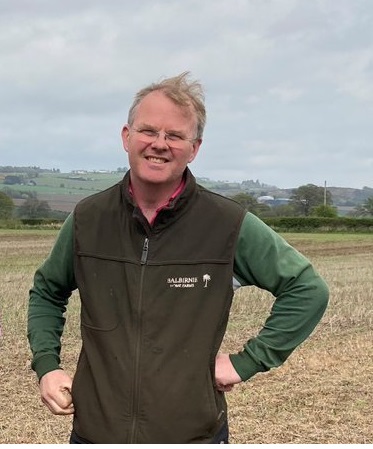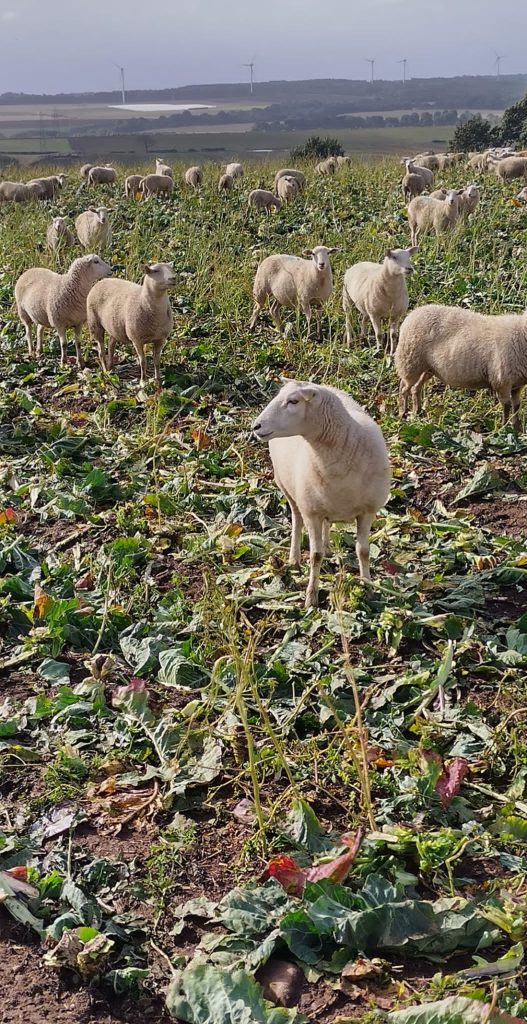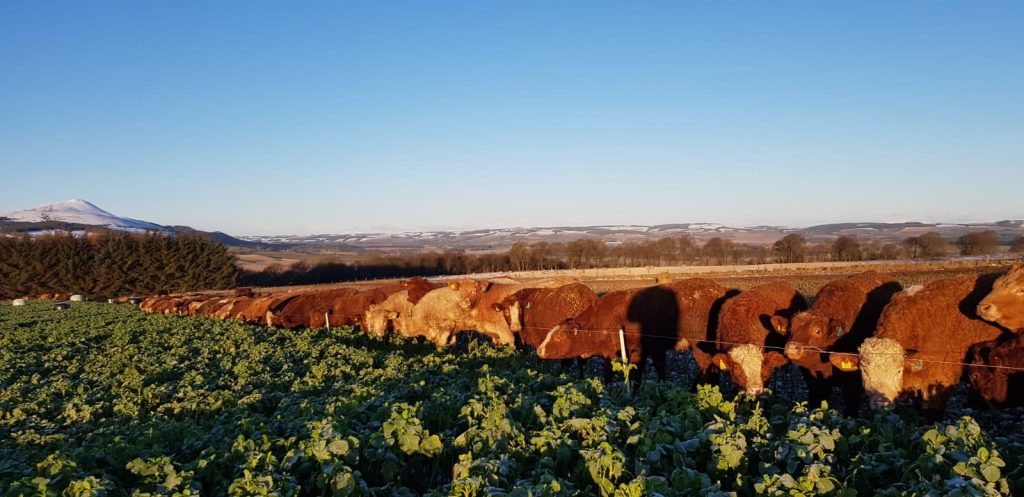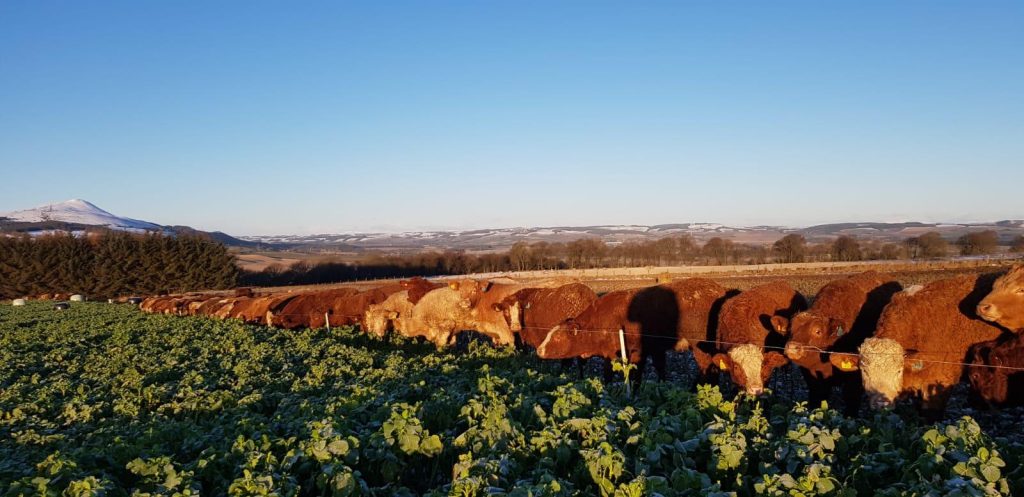January 2023
What livestock means at BHF?
Balbirnie Home Farms in hand farming operation comprises some 1200ha, two thirds of which is in an arable rotation, the remainder is permanent grass. Additionally, there is 380ha woodland and commercial forestry. The arable rotation currently consists of winter wheat, winter and spring beans, winter and spring oats, spring barley, kale, carrots, potatoes, cauliflower and some short-term herbal leys.
Our crop establishment system is ‘as little as we can get away with’. We aim to direct drill as much as we can but will cultivate appropriately as and when necessary. Obviously, the vegetable and root crops necessitate this to a greater degree.
We have 150 suckler cows, aiming to finish all progeny under the ‘Pasture for Life’ banner. The cows have been a fixture at Balbirnie forever and a day. They are grazed on grass throughout the summer with large mobs on daily moves to ensure maximum productivity from the grass. We have moved over to this system of grazing over the last 8 years.
This change to the cattle grazing was spurred on by a requirement to reduce costs and to make more of the resources we have on the farm. We have moved from a system where cattle grazed grass in summer, were housed all winter, and the only interaction with the arable land was the application of dung and the removal of copious amounts of straw for bedding and grains for feed. We were always busy on the ground feeding, bedding and mucking out etc, whilst the farm office was always busy writing cheques!
From 2013 we spent a few years feeding cows on stubbles through part of the winter, still harvesting and carting all the feed mechanically. We introduced kale as a winter forage crop in 2018. The intention was to winter all cattle outside, including youngstock. The realisation that the animals are all equipped with an in-built harvesting, processing and dung spreading system, has transformed how we manage them now. It’s amazing how we can get stuck in a mindset of repetition because we are worried about change. Instead of taking the food to the cow, we now take the cow to the food, and she does her thing.




Outwintering youngstock has been the steepest learning curve, we have made plenty mistakes and had days that could have, at best, been described as, ‘not our finest hour’. However, errors are now far fewer, cattle thrive within the system and costs have fallen off a cliff. The cows now work for us, previously we seemed to do an awful lot of work to keep them happy. Output has shrunk a bit, but we are confident that will return and generally life is a lot easier.
The introduction of kale gave us another break crop in the arable rotation, leaving a wealth of fertility in its wake each year. This allows us to cut the nitrogen applied to spring crops to 40kg/ha the following season, whilst maintaining good yields. This was a promising start to the integration of the livestock back onto the arable land.
The obvious drawback is the cows are heavy and the soil is wet during the winter, so there is some structural damage. The aim is to direct drill the forage crops. Generally, the cows will only sink in a little more than the depth of the cultivation, so reduce the cultivation depth at establishment, and the intensity of the remedial work after the winter in reduced.
But at 40ha a year, we are going to take a long time to get round all the arable land, added to this is the fact that cattle outwintered are not especially conducive to direct drilling the following spring. So, what is the answer?
We need to build the fertility and integration over a far larger area. So, we need to find a lighter and more numerous fertility processor. The answer we hope, is sheep. We were fortunate enough to have been approached by a pair of enthusiastic sheep keepers this summer. Our businesses had potential to dovetail into one-another and after some thought, we took the plunge. Current thinking is to grow greenery on every acre we can through the winter and use the sheep to recycle this fertility round to the following season. To this end, we have cover crops on all but 8ha at the moment. They are now being eaten by 800 store lambs and 700 breeding ewes.
It seems daft looking back now, but we had always thought we would have to own the sheep in order to get the management we required. Our minds have been opened up now to all sorts of possibilities as to how we develop the business going forward.
We have had our fair share of failures on the cover crop front over the years. The later season in Scotland makes establishing the more fashionable small seeded species risky and uncertain. We have settled on using beans, peas, oats and rye as our main stays. The larger seeds can cope with later sowing and still produce a worthwhile result.
Prior to the arrival of a year-round sheep enterprise, we had tried to grow a 16 way multi-species cover crops during the summer. The idea was to create a feasible break crop that could feed cattle during the warmer and drier times of the year. This would serve to expand our fertility building options over a larger area using the livestock we already had. 2021 was the first attempt, we grew 90t/ha fresh-weight of lush green biomass over 14ha. This seemed too easy with only the seed as a cost, no fertiliser or other inputs. Summer 2022 came, we upped the area to 60ha… I didn’t even bother to measure the result, the photographs will do all the explaining. Suffice to say, we won’t be repeating the exercise next year.
The team are hard at work upgrading our water supply at one end of the farm as we have been relying on natural springs for much of the grazing area. The flow reduced on one and ceased on another this summer due to the dry weather. This has become a repetitive issue with the larger groups of cattle. Fencing also continues at pace as we try to ensure the farm is stock proof, but this will take a lot of years to complete.
The routine of moving electric fences will continue through the winter, ensuring all livestock thrive as intended and we minimise the structural damage to the soil and maximise the fertility benefits they can bring to the farm. Lots of time will be spent planning how we operate our grazing system with the additional stock in the coming growing season. Can we run a mob of sheep and cattle together? Can we refine cover crop establishment to allow more diversity? We are confident of our ability to grow sufficient food for the winter, but how will our grass hold up in the drier seasons? Our journey will continue through our own tinkering and constant learning by talking to other producers, exchanging ideas. Now is the time to push the system.

Summer grazing




